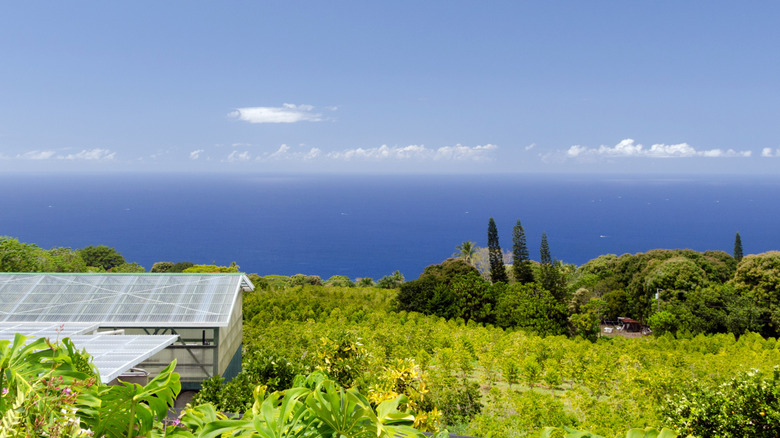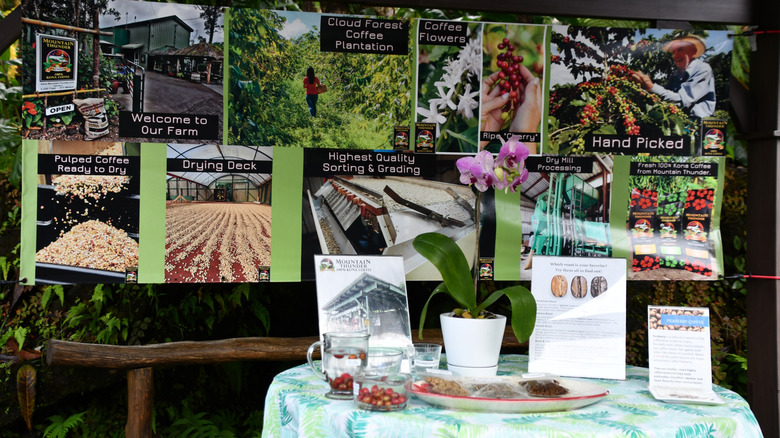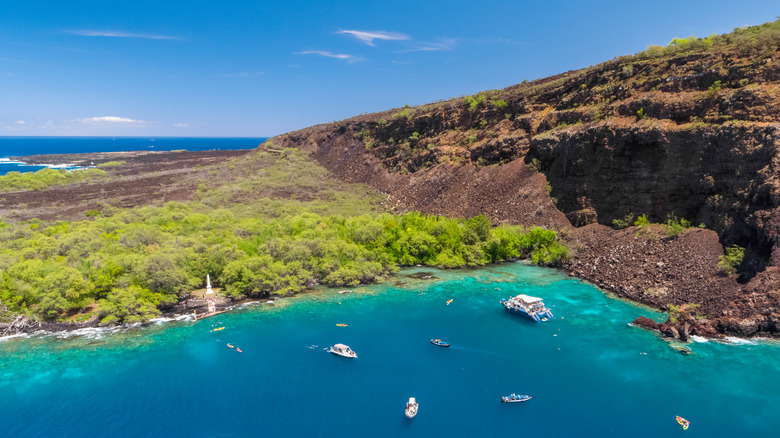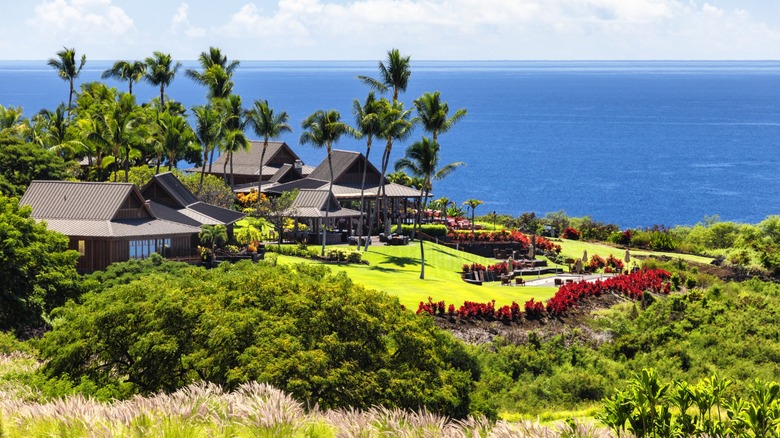This Lush Region Along Hawaii's Big Island Coast Offers Coffee Farms, Historic Landmarks, And Scenic Vistas
Sweeping about 30 miles along Hawaii's western coast lies the Kona Coffee Belt, a verdant and mountainous swath with conditions perfect for coffee production. While Honolulu is considered one of the five best destinations in America for coffee lovers due to its proliferation of coffee shops, the Kona Coffee Belt is the birthplace of the world-famous Kona Coffee, and here you can still visit working coffee farms. The history of Kona Coffee begins in the 19th century when missionary Samuel Ruggles planted Brazilian coffee trees in Kona. The region's stable and warm climate, plentiful rainfall, volcanic soil, and high elevation ensured prolific coffee production, and soon the region had hundreds of working farms. Today, coffee is only grown in two U.S. states, Hawaii and California. However, beyond touring coffee farms, the region around the Kona Coffee Belt also has a lot to offer, from hiking in national parks to relaxing at idyllic beaches.
The Kona Coffee Belt is easy to access and starts just a short distance from Kona International Airport. The ideal road trip through the Kona Coffee Belt runs along the Coffee Belt Road, also known as Highway 180. The region can be visited year-round, but for prime outdoor weather, visit during the dry-season months of May through October when average temperatures hover around 80 degrees Fahrenheit and there is little rainfall.
Coffee tours on the Kona Coffee Belt
There are hundreds of coffee farms dotting the Kona Coffee Belt, but for an overview of Kona's coffee culture, start at the Kona Coffee Living History Farm, where coffee culture and history blend on a working farm. On the National Register of Historic Places, the Kona Coffee Living History Farm transports guests to the early 20th century, showcasing how a coffee farm worked and how its farmers lived. However, make sure you time your visit in advance, as the farm is only open Tuesdays and Fridays from 10 a.m. to 2 p.m. Another top visit is Greenwell Farms, which offers complimentary tours of their coffee farms and processing facilities daily from 9 a.m. to 3 p.m. Visitors can also book a semi-private coffee tasting or brewing class.
Don't miss a stop in Holualoa, a lesser-known town for Hawaii's best coffee and art scene. Head to the Mauka Meadows, a beautiful coffee farm and shop. Visitors will meander through a flowering garden trail to reach the gift shop, where you can sample freshly roasted coffee in a picturesque setting next to an infinity-edge pool overlooking the ocean. You can also purchase 100% Kona coffee beans to take home. "This is one of our favorite stops on the Big Island, and people don't seem to know about it," wrote a Tripadvisor reviewer. "The grounds are beautiful, and the infinity pool overlooking the ocean is a great place to relax and drink coffee." Another great visit is the Mountain Thunder Coffee Farm, where coffee trees are grown at a 3,200-foot elevation in a cloud forest. The farm offers free 20-minute tours daily of their mill and roastery.
Enjoying nature on the Kona Coffee Belt
After you've savored some of the famous Kona coffee, explore some of the historic and cultural landmarks that dot the Kona Coffee Belt. Nature and history lovers should visit the Kealakekua Bay State Historical Park, where Captain James Cook landed ashore in 1778. Today, you can hike through lush trails and see The Captain Cook Monument or head out into Kealakekua Bay for snorkeling or boating adventures. The crescent-shaped bay is a Marine Life Conservation District, and its healthy coral reefs promise incredible snorkeling alongside spinner dolphins and tropical fish. Avid hikers should embark on the Captain Cook Monument Trail that leads from the foothills of the Kona Coffee Belt towards the coast and is a nearly 4-mile loop.
Further north, another important park to visit is Kaloko-Honokōhau, a national historical park full of beaches and tide pools. The 1,200-acre park was once home to ancient Hawaiian settlements, which is still evidenced by rock carvings. Today, visitors can hike, enjoy beach time at Honokōhau Beach, spot native wildlife, and see ruins of an ancient Hawaiian fishing village.
Where to stay on the Kona Coffee Belt
To explore the Kona Coffee Belt properly, base yourself along the route (or near the coast) so you can easily visit coffee farms, national historic parks, and beaches. For a truly immersive experience, stay at a boutique inn set on a working coffee farm. The Holoulua Inn is nestled on 30 acres amongst coffee trees and tropical fruit groves. With just eight rooms, suites, and cottages, the intimate inn provides an authentically Hawaiian experience with panoramic ocean views and the perfect base for exploring the Kona Coffee Belt. Another option is the Ka'awa Loa Plantation, an affordable option of modest but charming rooms and cottages on a classic plantation house estate perched above the Kealakekua Bay State Historical Park. The Ka'awa Loa Plantation serves a bountiful breakfast with freshly roasted coffee and tropical fruits grown on site.
If you've become truly enthralled by this special region of Hawaii, you can even purchase property and plant roots here. Sprawling along the coastline is Hokulia, a luxurious residential community and private club of nearly 1,300 oceanfront acres. Owners who purchase a residence or a lot can enjoy all the amenities Hokulia has to offer, set against the spectacular backdrop of the Pacific Ocean. The community boasts an 18-hole Jack Nicklaus-designed golf course, the alfresco Pavilion restaurant and bar, tennis courts, a gym, swimming pool, and much more. For those inspired by the farming culture of the Kona Coffee Belt, Hokulia provides farm plots for owners interested in gardening and harvesting their own fruits and vegetables, which can then be sold at local farmers markets.



